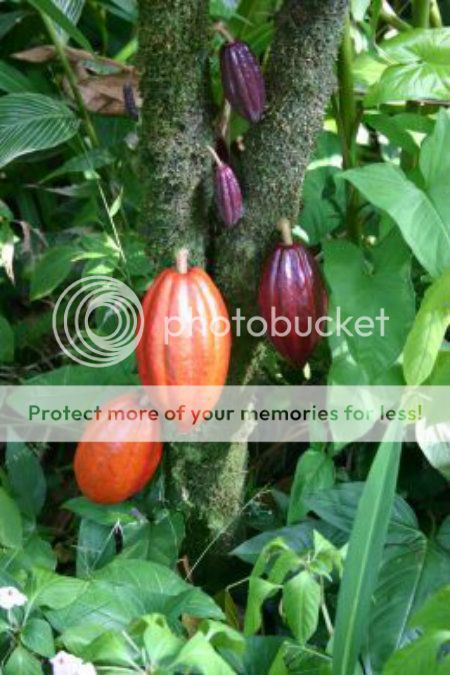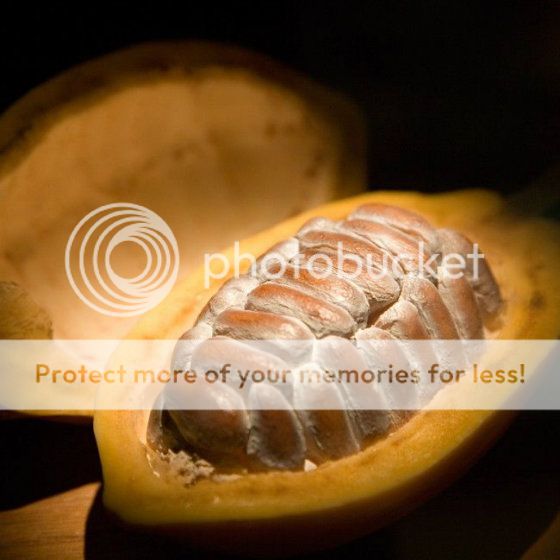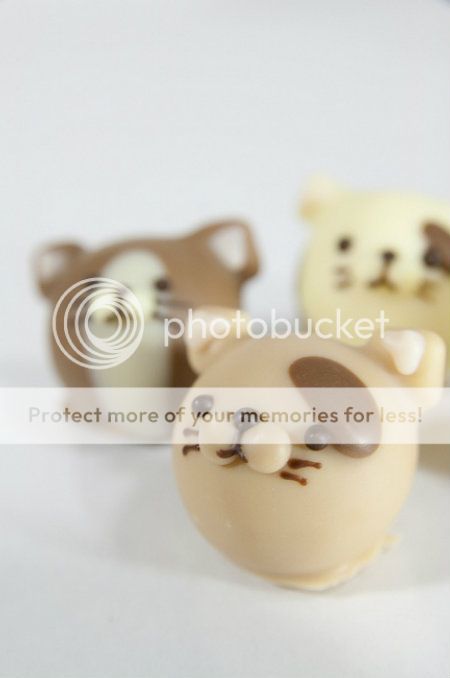-
*Astrella.
User deleted
The legends of Chocolate

Theobroma cacao also cacao tree and cocoa tree, is a small (4–8 m (13–26 ft) tall) evergreen tree in the family Malvaceae, native to the deep tropical regions of Central and South America. Its seeds, cocoa beans, are used to make cocoa mass, cocoa powder, and chocolate.
Cacao (Theobroma cacao) belongs to the genus Theobroma classified under the subfamily Sterculioidea of the mallow family Malvaceae. Cacao is one of 22 species of Theobroma.
The generic name is derived from the Greek for "food of the gods"; from θεος (theos), meaning "god," and βρῶμα (broma), meaning "food".
The specific name cacao is derived from the native name of the plant in indigenous Mesoamerican languages. The cacao was known as kakaw in Tzeltal, K’iche’ and Classic Maya; kagaw in Sayula Popoluca; and cacahuatl[dubious – discuss] in Nahuatl.
Cacao flowers.
Cupuaçu, Theobroma grandiflorum, is a closely related species found in Colombia, Peru, Bolivia and Brazil. Like cacao, it is also the source for a kind of chocolate known as cupulate or cupuaçu chocolate. Cupuaçu is considered as having high potential by the food and cosmetics industries.
History of cultivation
Cultivation, use, and cultural elaboration of cacao were early and extensive in Mesoamerica. Ceramic vessels with residues from the preparation of cacao beverages have been found at archaeological sites dating back to the Early Formative (1900-900 BC) period. For example, one such vessel found at an Olmec archaeological site on the Gulf Coast of Veracruz, Mexico dates cacao's preparation by pre-Olmec peoples as early as 1750 BC. On the Pacific coast of Chiapas, Mexico, a Mokaya archaeological site provides evidence of cacao beverages dating even earlier, to 1900 BC. The initial domestication was probably related to the making of a fermented, thus alcoholic beverage.
Several mixtures of cacao are described in ancient texts, for ceremonial or medicinal, as well as culinary, purposes. Some mixtures included maize, chili, vanilla (Vanilla planifolia), and honey. Archaeological evidence for use of cacao, while relatively sparse, has come from the recovery of whole cacao beans at Uaxactun, Guatemala[ and from the preservation of wood fragments of the cacao tree at Belize sites including Cuello and Pulltrouser Swamp. In addition, analysis of residues from ceramic vessels has found traces of theobromine and caffeine in early formative vessels from Puerto Escondido, Honduras (1100-900 BC) and in middle formative vessels from Colha, Belize (600-400 BC) using similar techniques to those used to extract chocolate residues from four classic period (circa 400 AD) vessels from a tomb at the Maya archaeological site of Rio Azul.
As cacao is the only known commodity from Mesoamerica containing both of these alkaloid compounds, it seems likely these vessels were used as containers for cacao drinks. In addition, cacao is named in a hieroglyphic text on one of the Rio Azul vessels. Cacao was also believed to be ground by the Aztecs and mixed with tobacco for smoking purposes.
Currency system
Cacao beans constituted both a ritual beverage and a major currency system in pre-Columbian Mesoamerican civilizations. At one point, the Aztec empire received a yearly tribute of 980 loads (xiquipil in Nahuatl) of cacao, in addition to other goods. Each load represented exactly 8,000 beans. The buying power of quality beans was such that 80-100 beans could buy a new cloth mantle. The use of cacao beans as currency is also known to have spawned counterfeiters during the Aztec empire.
Listening to Aztec Chocolate legends, chocolate myths and other interesting facts about chocolate while sitting around a crackling fire only adds to the mystery and allure of Chocolate stories. Chocolate legends make fascinating stories that provide insight into how others saw the world around them and created Cacao stories that have been passed down from generation to generation.
Myths and legends of Chocolate reflect our ancestor's belief systems. Cacao legends offer good moral values, truths within truths and a mix elements of fact and fiction. Communities are built with like minded individuals sharing common values, and it isn't any different with Chocolate Communities. Isn't it reassuring and comforting to realize that your chocolate obsession is considered quite natural and normal with others passionate about Chocolate? Real chocolate.
Legends of Chocolate and myths about chocolate reveal the truth to others only developing their chocolate mania and helps them open up and share their chocolate story. You can amuse, entertain, teach and learn about the legends that come with chocolate. The story of chocolate surpasses all time and cultures, some events are truthful, others symbolic, many are expanded, tweaked and twisted taking on new chocolate stories of their own creation.
In the end stories, myths and legends will always be shared and enjoyed and, short of indulging your Chocolate Child. What could be more amusing than sharing some stories about chocolate?
Mesoamerica
Cacao, or chocolate, from the Theobroma cacao tree is an ancient super food evolving around 15,000 years ago where the tree grew wild, blossomed and thrived in the moist tropical rainforest floor of the Amazon basin. Sacred Chocolate has been appreciated as a medicinal food for about 2,600 recorded years. The history of Cacao and it's current political pressures are fascinating, covrting everything from ancient beginnings to current corporate feuds.
Early Mayan records from 2,600 years ago show that Cacao has been appreciated and cultivated as a medicinal food plant. It is believed that the Olmecs were the earliest cultivators of Cacao from 1200 BC -400 BC, while they didn't leave much record of their cacao use we do know that the Aztecs and Mayans of modern day Mexico esteemed cacao where it played an important role in their society where cacao beans were used as a currency and included in sacred ceremonies, rituals and celebrations.
The deep, bitter raw cacao drink was enjoyed by most of the Mayan population from 250 AD to 900 AD. The Mayans were also the first to develop Cacao plantations to increase the yields of this important crop. Mesoamericans knew by 1,000 BC that Cacao didn't do well as a monocrop. Cacao requires an integrated rainforest ecosystem with balanced diversity of other crops to attract sufficient pollinators and to minimize the tendency of Cacao to develop pod rot, which destroyed Costa Rica's Cacao crop in the 1980's. Nature always knows best and will always win against man's interventions.
Xocolatl (ho co la tol) meaning bitter liquid was what the Aztecs called the unsweetened cacao drink which was blended with chili peppers, vanilla or honey. Many medicinal herbs were often used, nothing tastes better than the combination of Cacao and Maca. Maca is an ancient Andean food that has traditionally been used to enhance stamina, strength and sexual vigor. Maca is an adaptogen herb with the ability to harmonize and balnce the body's energy and hormonal levels. If your body requires energy, Maca can help without over stimulating the body. It has a slight, natural sweet taste and benefits the adaptability of the entire body.
New Years was celebrated by the srrival of the Possum God who carried the Rain God bringing Cacao offerings to the people. One of the few Mayan books that escaped burning by the Spanish conquistadores shows the representation of the Possum God, it can be found in the Dresden Codex. The Dresden Codex: Drawings of the Pages (Mayan Studies : No 3)
The Toltecs worshipped Quetzalcoatl, or the star that comes in the afternoon. This star is known to us as Venus. They built him a large 5 story temple. There were other Gods who followed Quetzalcoatl teaching the people the wisdom of the seasons, the plants, architecture, masonry artistry, the arts and sciences and how to follow the stars. These were gifted people of intelligence, commonly mistakenly viewed today as primitive and unlearned.
Quetzalcoatl cared for his people and gifted them a sacred plant that was reserved for the Gods. The people were instructed on how to care for the sacred fruit, how to pick the pods and roast the kernels. They called this bitter drink Chocolatl and it was reserved just for royalty, priests and Gods. When the other Gods discovered that Quetzalcoatl had stolen their sacred Cacao secrets and shared it with the Toltecs they became enraged and jealous of this prosperous and educated people. They would choose to go to war on Quetzalcoatl and those who followed him. Aztec sculpture of a man holding a cocoa fruit.
Aztec sculpture of a man holding a cocoa fruit.
The arch enemy of Quetzalcoatl was the God of the Morning Star, Tezcatlipoca, who disguised himself as a merchant and approached Quetzalcoatl with the intention to deceive and disgrace him. When Tezcatlipoca learned that Quetzalcoatl was fearing for his downfall and the safety of his people, the false merchant gave him a potent alcohol fermented drink made from the Agave cactus, it was called pulque. He tempted Quetzalcoatl by lying and telling him that drinking the drink would make him and his people happy. Trusting the deceptive God, Quetzalcoatl drank himself silly and caused his people to get drunk too, only adding to his disgrace.
Quetzalcoatl lost face, felt disgraced and shamed when he was mocked by the other Gods. Not being able to face the physical destruction of the magnificent city of Tolan and the death of his people he left, headed in the direction of the evening star. Passing from the land of his people he was discouraged to see that the sacred Chocolatl had changed into thorny dry plants and had turned themselves into Agave cactus, the very drink that the false God had deceived him with! His walk continued for days. Walking to the sea he planted the last Cacao seeds which would flourish and be known as the last gift from Quetzalcoatl to his beloved people of Mexico.
Goddess Sephra
Legend reveals that it was the sultry Goddess and Aztec beauty, Sephra, who bestowed the sacred gift of Cacao upon the Aztecs. Sephra's spirit nurtured and fed the Sacred Cacao trees and it was believed that she lived within the Cacao beans. Her voice was gentle, silky soft with a gentle aroma of Cacao.
The Aztecs called the Cacao tree, the "Food Of the Gods" it was so highly valued and reserved for royalty. Cacao beans were used as a currency and to pay tribute to royalty and part of sacred, ceremonial offerings. Legend holds that Montezuma had skilled artisans craft a temple to honor Sephra. His hope was that Sephra would continue to bless his people with this priceless crop. Montezume was a professed lover of Cacao, it is said that he drank 50 cups daily. Likely those were diminutive cups, not super size.
Easter Legends
The egg has been considered as an ancient symbol of life, birth and hope. It is believed that the Crusaders brought Eastern traditions to Europe when they returned, among those were the traditions of the egg and it's special significnce.
The Anglo Saxon Goddess of the Dawn was named Ostara or Eostre, from which our English word of Easter has it's origins. The first day of spring was reserved as a festival to honor Ostara and the birth of the life giving season of Spring. Like other Goddesses, Ostara had a craft or two up her sleeve and after she changed a bird into a rabbit, the rabbit too became part of the rituals snd traditions surrounding that Easter symbol.
Germans created the first sweet Easter Rabbit in the early 19th century, today millions of Chocolate Easter Bunnies and Chocolate Easter Chicks of every imaginable type are stuffed into decorated Easter baskets and enjoyed by children and adults alike. You can enjoy floppy ear rabbits of every color and shape and chocolate covered everything you can imagine.
Mythology
The Maya believed the kakaw (cacao) was discovered by the gods in a mountain that also contained other delectable foods to be used by them. According to Maya mythology, the Plumed Serpent gave cacao to the Maya after humans were created from maize by divine grandmother goddess Xmucane. The Maya celebrated an annual festival in April to honor their cacao god, Ek Chuah, an event that included the sacrifice of a dog with cacao-colored markings, additional animal sacrifices, offerings of cacao, feathers and incense, and an exchange of gifts. In a similar creation story, the Mexica (Aztec) god Quetzalcoatl discovered cacao (cacahuatl: "bitter water"), in a mountain filled with other plant foods. Cacao was offered regularly to a pantheon of Mexica deities and the Madrid Codex depicts priests lancing their ear lobes (autosacrifice) and covering the cacao with blood as a suitable sacrifice to the gods. The cacao beverage as ritual was used only by men, as it was believed to be toxic for women and children.
Modern History
The first Europeans to encounter cacao were Christopher Columbus and his crew in 1502,[citation needed] when they captured a canoe at Guanaja[citation needed] that contained a quantity of mysterious-looking "almonds". The first real European knowledge about chocolate came in the form of a beverage which was first introduced to the Spanish at their meeting with Moctezuma in the Aztec capital of Tenochtitlan in 1519. Cortez and others noted the vast quantities of this beverage the Aztec emperor consumed, and how it was carefully whipped by his attendants beforehand. Examples of cacao beans, along with other agricultural products, were brought back to Spain at that time, but it seems the beverage made from cacao was introduced to the Spanish court in 1544 by Kekchi Maya nobles brought from the New World to Spain by Dominican friars to meet Prince Philip. Within a century, the culinary and medical uses of chocolate had spread to France, England and elsewhere in Western Europe. Demand for this beverage led the French to establish cacao plantations in the Caribbean, while Spain subsequently developed their cacao plantations in their Venezuelan and Philippine colonies (Bloom 1998, Coe 1996). The Nahuatl-derived Spanish word cacao entered scientific nomenclature in 1753 after the Swedish naturalist Linnaeus published his taxonomic binomial system and coined the genus and species Theobroma cacao.
Traditional pre-Hispanic beverages made with cacao are still consumed in Mesoamerica. These include the Oaxacan beverage known as tejate.
Continua: www.international-chocolate-bar-association.com/Legends.html
http://en.wikipedia.org/wiki/Theobroma_cacao.
The legends of Chocolate |


